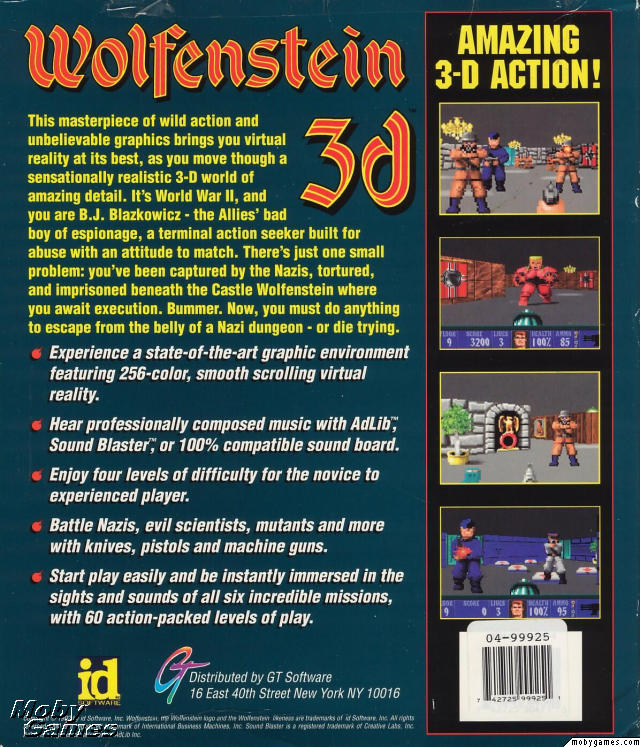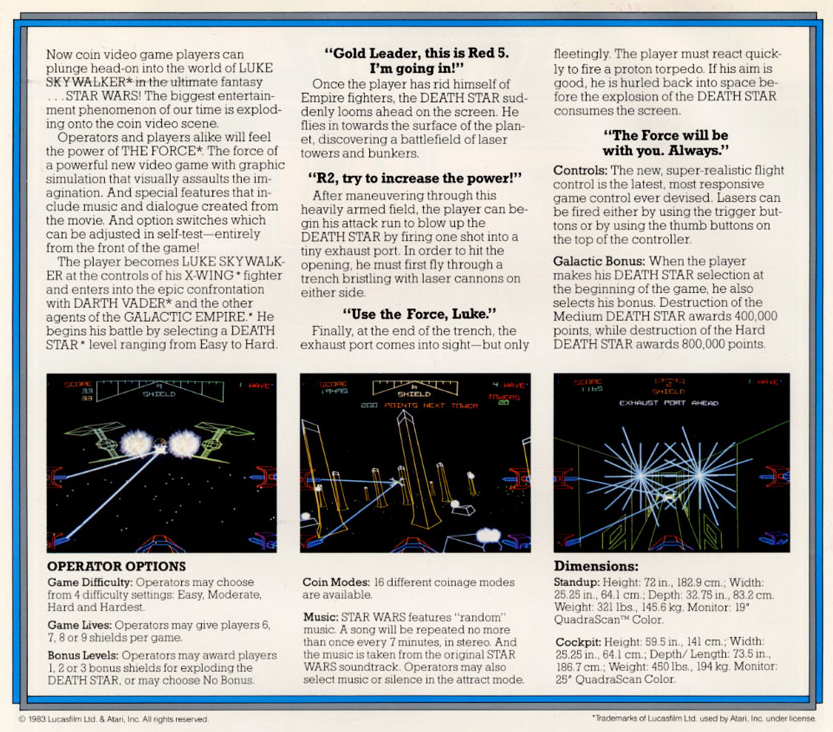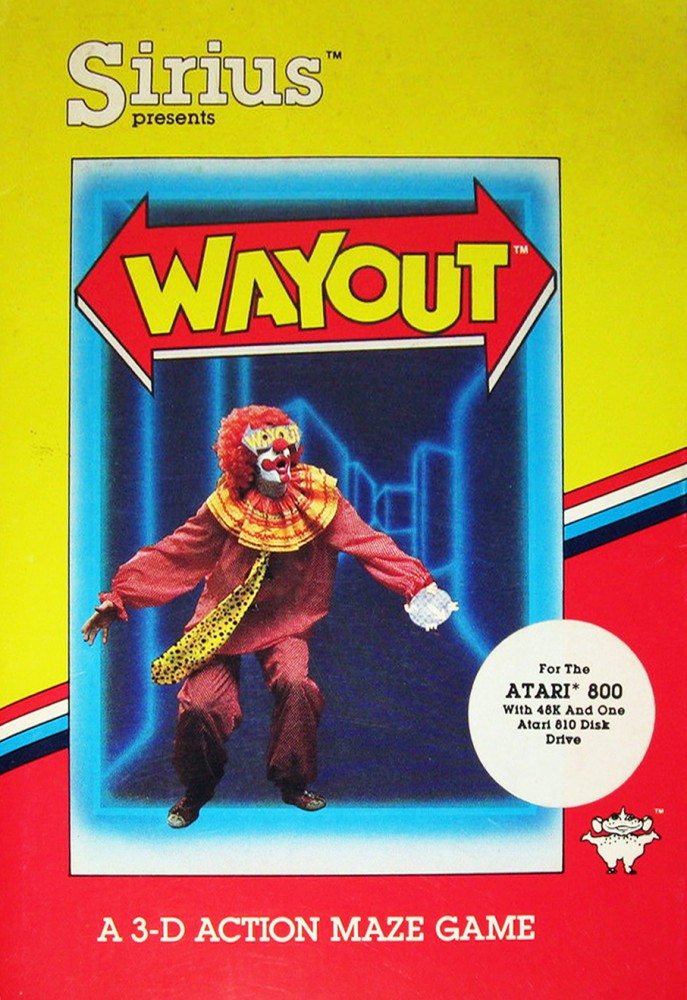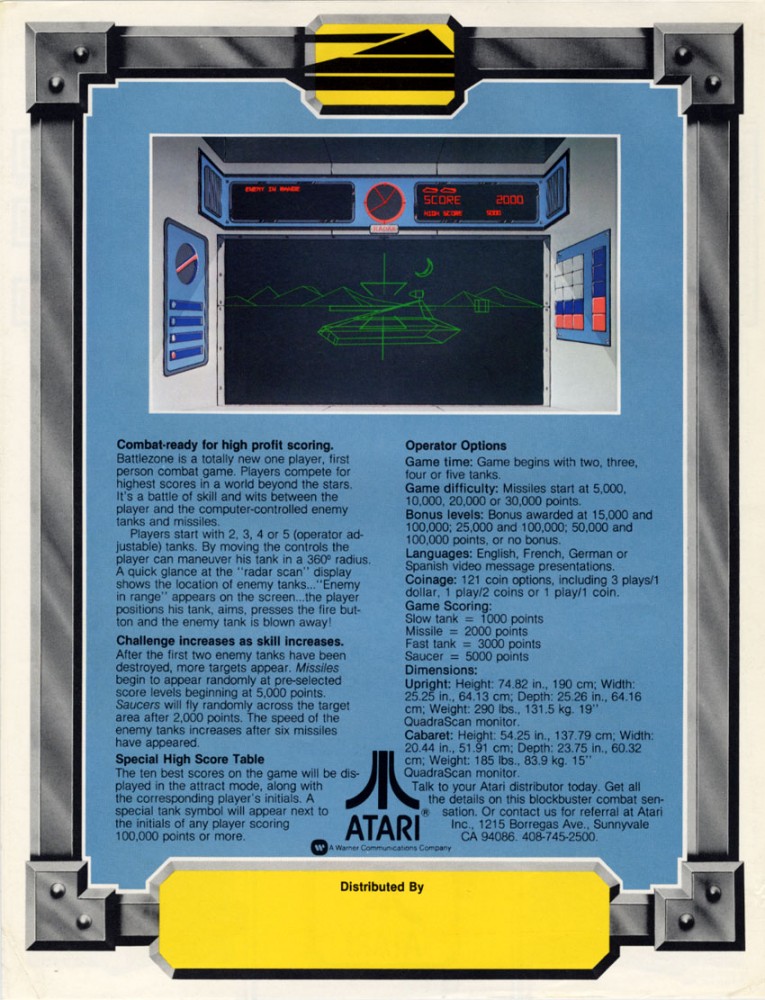I’ve been working on a paper to document the rise of the expression “first person shooter” in the gaming community. I’ve started by looking at lists of relevant games, as well as titles mentioned in academic papers. Thanks to the availability of old game magazines, arcade flyers and printed ads, I’ve been able to do extensive research to determine if “first person shooter” or “first person” were used in the relevant peri/paratextuel elements of the listed/quoted games. I’m really fascinated by the findings so far. Alleged “precursors”, such as shooting galleries and tank games, were not tagged with these expressions most of the time; other buzzwords such as 3D or smooth scrolling were more prevalent. For pilot games, what we now describe as “third person” was often designated as “first person”. You can check out some of these preliminary findings below.
I must thank the dedicated members of our community who spent significant amounts of their time to scan and distribute many of the peri/paratextual elements I’ve used for this project.
A convenient starting point
In popular accounts as well as many scholarly efforts (Bryce & Rutter, 2002:67; Kline et al., 2003:84; Rehak, 2008:193; Loguidice & Barton, 2009:51; Voorhees et al., 2012:2), the history of first-person shooters truly begins with popular games released by id Software, such as Catacomb 3-D (1991) and Wolfenstein 3-D (1992). Previous efforts that fit the genre’s criteria are often discussed as precursors. While it is undeniable that the commercial explosion came with id’s games, it is interesting to note that the company’s marketing efforts refrained from using the expression “first-person shooter”. The titles make it clear that another buzzword was still dominant at the time: 3-D. As we can see on the game boxes, it was not the only craze that would feed marketing efforts at the beginning of the 1990s: Wolfenstein 3-D was described as “smooth scrolling virtual reality, as you move through a sensationally realistic 3-D world of amazing detail” (fig. 1); Doom was also presented as a virtual reality experience (Loguidice & Barton, 2009:58). The buzzword was everywhere in the early 1990s; Battlezone (Atari, 1980) was even retrospectively called “Virtual Reality for a quarter” by Wired magazine. Usage of the expression “first-person” occurs retrospectively on many objects that were not referred to in the exact same terms. While the meaning often coincide with other expressions in use throughout the 1970s and 1980s, “first-person” is clearly a contemporary fascination.
 Figure 1. VR marketing (Wolfenstein 3-D, id Software, 1992). Source: www.mobygames.com
Figure 1. VR marketing (Wolfenstein 3-D, id Software, 1992). Source: www.mobygames.com
Virtual reality
In his 1991 book about virtual reality, Howard Rheingold introduced Morton Heilig as a precursor. Heilig’s Sensorama – designed in the early 1960s but never released for the general public – provided a multimodal illusion of a ride in the streets of New York City; the device included stereo moving images and sound, along with a vibrating seat, handlebars, sensations of wind and a variety of aromas. In the patent documentation, Heilig doesn’t use the expression “first-person”, but makes it clear that the object of the invention is “to provide an apparatus for simulating an actual, predetermined experience in the senses of an individual” (1962:1).
In 1968, Ivan Sutherland described the first major head-mounted display system at the AFIPS Fall Joint Computer Science conference. The Sword of Damocles device was able to detect the position of the user’s head, and adjust the wireframe display of a 3-D world accordingly. Yet in the corresponding paper, the expression “first-person” is nowhere to be found (Sutherland, 1968). Rather, the engineer discusses the technological underpinnings of the “dynamic perspective display” (1968:759) that allows the image to move according to the user’s point of view.
Shooting Galleries
Wolf suggests that we could consider any “shooting galleries on carnival fairground” as the very first first-person shooter games (2012: 26).The keyword “1st-person” also appears in the field “perspective” for the majority of games associated with the shooting gallery formula on the popular web database Mobygames. This is a prime example of the contemporary fascination with the term. Coin-operated mechanical shooting galleries have existed long before the advent of video games; there are known examples of such machines dating as far back as 1895 (Automatic shooting range, by Mechanical Trading Co.) and electromechanical shooting games flooded the arcades after the success of Shoot the Bear (Seaburg, 1947): Safari Gun (Williams, 1954), Shooting Gallery (Exhibit Supply, 1954), Periscope (Sega, 1968) are just a few noteworthy examples. Needless to say, shooting galleries predate the coin-op development. In a sense, these play scenarios occur in “first-person”, but one would be hard-pressed to find a description of the experience in those terms outside of contemporary literature. It appears that the “first-person” nature of this experience was too implicit to be distinguished through language; it is a direct continuation of a practice that involved the body – and the eyesight – in a way that is very similar to the actual experience of shooting, defined by the same basic skills of aligning a reticule with a target and timing the trigger and reload actions (Wolf 2012:569).
Perspective
Early games in the adventure and RPG genre are associated with the emergence of the first-person point of view in gaming. The full screen drawings in The Hobbit (Beam Software, 1982) or Déjà Vu: A Nightmare Comes True (ICOM, 1985) were easy to distinguish from the typical look of games made from 2D tile sets, which was either perfectly flat or included contradictory perspectives. The dungeon scenes in Akalabeth (Garriott, 1980) and Ultima (1981) follow the basic composition rules of perspective and mimic natural perception more closely than the typical drawings of early graphical adventure games. The arrays of simple oblique lines and “view by view” spatial exploration are reminiscent of Coley’s mainframe game Maze War (1974), a common starting point in first-person shooter lists. This design choice had a lot of influence on computer RPGs over the next 20 years, with long lasting series such as Wizardry (Sir Tech, 1981-2001), The Bard’s Tale (Interplay Productions, 1985-1988), Might & Magic (New World Computing, 1986-2002) Ishar (Silmarils, 1990-1994) and Eye of the Beholder (Westwood, 1991-1995). Although all these are often referred to as “first-person” experiences in contemporary literature and databases, they were not described as such on the boxes and in printed ads throughout the 1980s. Through the Ziploc bag, Akalabeth’s original cover piece brags about its “perfect perspective”, but the preferred expression for most of the dungeon crawler genre was “3-D”, as one can see on the back covers of the first games in the Wizardry and Might & Magic series (New World Computing, 1986). “3-D scrolling” was also common (The Bard’s Tale, 1985; Legacy of the Ancients, Quest Soft, 1987), even though the progression through space was not very smooth and rather elliptical when compared to vertical or horizontal scrolling games.
Depth exploration
Video game engineers have come up with many techniques to simulate the exploration of the z axis a long time before the elliptical “view by view” exploration of early RPGs. In 1976, Atari’s Night Driver used a dynamic array of white squares to simulate driving on a sinuous road from the perspective of the driver. Arcade owners were told in the flyer that the machine “places the driver in the cockpit of his own Sebring type racer”. Years later, the popular Pole Position (Namco, 1982) still used a “presence through perspective” rhetoric to sell the game. Star Wars (Atari, 1983) goes one step further and associates the experience of its dynamic perspective vector display to a form of identification with a popular character: “The player becomes LUKE SKYWALKER at the controls of his X-WING fighter” (fig. 2). Racing or flying games from the electromechanical era such as Sega’s Jet Rocket (1970), which already integrated steering wheels or yokes, held similar claims without necessarily presenting the action from the pilot’s point of view. Night Driver was likely inspired by a similar German game, Nürburgring1, designed by Reiner Foerst (1976); the original flyer points out the “naturgetreuem perspektivischen” of the game, which translates to “lifelike perspective”. But here again, the typical “pilot” game used “3-D” as a marker of technological attraction (Starhawk, Cinematronics, 1977; Speed Freak, Vectorbeam, 1979).
Figure 2. The player becomes Luke Skywalker (Star Wars, Atari, 1983). Source: http://flyers.arcade-museum.com/
The visual effect of travelling on the depth axis has been associated sporadically with the expression “first-person” in video game magazines, even for racing games and shooters that correspond more specifically to what is called “third person” in contemporary taxonomies. In his EGM cover story “Next Generation Gaming” on the upcoming consoles from Sega, NEC and Nintendo in July 1989, Steve Harris describes Victory Run for the Turbografx-16 (Hudson, 1987) and Super Thunderblade (Sega, 1988) for the Genesis as “first-person”, even though one can clearly see the car and chopper on the screenshots included in the article (1989: 35, 37). The same confusion appears to be frequent throughout these transitional years. For instance, in the March 1993 issue of Gamepro magazine, the reviewer for the racing game Outlander (Mindscape, 1992) describes its “behind the car view” as first-person (1993:128).
Free movement
In 1980, Battlezone allowed players to actively explore space in any direction. The arcade flyer for the game does mention the first-person perspective, but the expression has not been used for games allowing 3-D spatial exploration consistently over the following decade. Much like in the case of Wolfenstein 3-D and Doom, buzzwords such as “3-D” and “smooth scrolling” were at least as preeminent. Many games have followed in Battlezone’s tank tracks; the vehicle simulation genre has been especially lucrative in the domestic computer market. The printed ads and packaging of Stellar 7 (Damon Slye, 1983) or Sherman M4 (Loriciel, 1989) put forth their outstanding 3-D graphics, made with wireframe and polygonal 3-D respectively. Starting with Space Station Oblivion (1987), Incentive Software has proposed a series of science fiction vehicular game all based on the polygonal Freescape engine. The back of the box highlights that the “revolutionary 3-D scaling and perspectives that change smoothly as you move around will give you the uncanny feeling that ‘you are there’”, and the sequel (Dark Side, 1988) adds “first-person” to a similar lengthy description. Incentive released a version of their Freescape modelling engine to the public (Virtual Reality Studio) in 1991.
Free exploration games have emerged outside of the Battlezone clone enclave relatively early. Paul Allen Edelstein’s Wayout (Sirius, 1982) proposed a very capable 3-D engine for the Atari 400/800 and Commodore 64 computers; the mazes of flat blue walls were rotated fluidly in response to user input, in front of a colorful background (fig. 3). The screen layout, with the perspective view on top of an overhead map, is clearly inspired by Colley’s Maze War. The visual design of Alternate Reality: The City (Paradise programming, 1985), an original RPG mixing fantasy and science-fiction elements, is reminiscent of Edelstein’s game: walls are moving smoothly in front of a colorful gradient background. Although the engine is a great achievement of the “smooth scrolling” feature boasted by the likes of The Bard’s Tale, it is bitmap-based and thus movement is also restricted. Even if these examples let go of the vehicular setting in favor of a “on foot” adventure, neither games nor their respective sequels are described with the expression “first-person”. Again, “3-D” was the preferred marketing option.
Figure 3. First person clown (Wayout, Sirius, 1982)
Hovertank 3-D (1991) is considered id’s first “testing ground for technology and concepts” (Loguindice & Barton, 2012: 56) that lead to Wolfenstein 3-D and Doom. The genre was thus a direct continuation of the trend set forth by Battlezone. The original control scheme of the id shooters make this observation even more obvious: the four arrow keys allowed the player to move forward / backward and to rotate the point of view. This layout is known in gamer culture as “tank controls”. In a very real sense, the visual exploration afforded to the player in these games occurred as the rotation of a vehicle.
First person adventures
Many of the objects associated with the “first-person shooter” generic tag nowadays were not described as “shooters” at the time of their release. At this stage of scholarly research, it is very risky to declare with absolute certainty when “first-person shooter” was used for the first time in gaming culture. As Steven L. Kent reports (2001:163), a design aid document circulating at Atari in 1979 listed “first person Space Invaders” among other game pitches; this is the idea that inspired Dave Theurer to create Tempest (1980). It is one of the earliest uses of an expression that can be directly equated with “first-person shooter” (even though the game corresponds to a third person shooter, by contemporary standards). In 1980, the Battlezone flyer described the “totally new” experience as “first person combat” (fig. 4). Considering the popularity of shooting games even before Space Invaders (Taito, 1978), the choice of “combat” is surprising. Shooting mechanics were already so common that Atari engineers conceived the graphic architecture of the VCS console around “player-missile graphics”. Sega’s Space Tactics (1980) and Nintendo’s Radar Scope (1980) clearly copied the formula that inspired Tempest, boasting “real-life 3-D” and “perspective effect” respectively.
Figure 4. Totally new first person combat (Battlezone, Atari, 1980). Source: http://flyers.arcade-museum.com/
Even though vertical and horizontal shoot’em ups remained a major genre throughout the 1980s, many games started exploring hybrid scenarios where shooting was just one part of the mechanics. Koronis Rift (Lucasfilm, 1986) was described as a “First person strategy and adventure”; it involved investigating shipwrecks and collecting items alongside the crosshair shooting action. Space Station Oblivion asked the player to position a drill in each level and to neutralize the deadly security systems through the activation of mechanisms in the environment. This diversity of action is also present in early id games. It might explain the company’s reluctance to market these games with the term shooter, favoring expressions such as ”amazing 3-D action!” (Wolfenstein 3-D) and “first-person adventure” (Doom). The PC Gamer quote on the Quake box (1995) speaks of an “atmospheric 3-D action game”. Many landmark games in the genre used “3-D” instead of “first-person” (Descent, Parallax Software, 1994; Duke Nukem 3D, 3D Realms, 1996); in Gamespot’s review, the latter is referred to as a “3D shoot’em up”. Most of these games integrate spatial exploration, activation of mechanisms in the environment, and minimal object management through the plurality of guns. The shooting mechanics, however, take center stage in the experience, and the packaging and ads often insist on the firepower and deadly weapons. This might explain why the press and community at large started referring to them systematically as “first-person shooters”.
References
Bryce, Jo and Jason Rutter. 2002. “Spectacle of the Deathmatch: Character and Narrative in First-Person Shooters”. In Screenplay. Cinema/Videogames/Interfaces, eds. Geoff King and Tanya Krzywinska, 66-80. London: Wallflower Press.
Galloway, Alexander. 2006. Gaming: Essays On Algorithmic Culture. University of Minnesota Press.
Harris, Steve. 1989. “Next Generation Gaming”. Electronic Gaming Monthly, (July): 31-39.
Heilig, Morton. 1962. Sensorama Simulator Patent documentation. Available online at http://www.mortonheilig.com/SensoramaPatent.pdf
Hitchens, Michael. 2011. “A Survey of First-person Shooters and their Avatars”, Gamestudies 11 (3) (December), available online at: www.gamestudies.org
Katz, Annie. 1989. “The Adventure Revolution”. Video Games and Computer Entertainment, (September): 80-81.
Kent, Steven L. 2001. The Ultimate History of Video Games. New York : Three Rivers Press.
Konzack, Lars. 2008. “Video Games in Europe”. In The Video Game Explosion. A History from PONG to PlayStation and Beyond, ed. M. J. P. Wolf, 203-210. Westport: Greenwood Press.
Loguidice, Bill and Matt Barton. 2009. Vintage Games. An Insider Look at the History of Grand Theft Auto, Super Mario, and the Most Influential Games of All Time. Burlington: Focal Press.
Meer, Alec. 2012. “The 39 best ever first-person shooter games”. PC Advisor, (August). Available online at http://www.pcadvisor.co.uk/
Metz, Christian. 1977. Le significant imaginaire. Psychanalyse et cinéma. Paris: Union Générale d’Édtions
Morris, Sue. 2002. “First-Person Shooters – A Game Apparatus”. In Screenplay. Cinema/Videogames/Interfaces, eds. Geoff King and Tanya Krzywinska, 91-97. London: Wallflower Press.
Perron, Bernard. 2008. “Genre Profile: Interactive Movies”. In The Video Game Explosion. A History from PONG to PlayStation and Beyond, ed. M. J. P. Wolf, 127-133. Westport: Greenwood Press.
Pinchbeck, Dan. 2007. “Counting barrels in Quake 4: affordances and homodiegetic structures in FPS worlds”, in Situated Play, Proceedings of DiGRA 2007 Conference, available online at www.digra.org/digital-library/publications
Pinchbeck, Dan. 2009. “Shock, Horror: First-Person Gaming, Horror, and the Art of Ludic Manipulation”. In Horror Video Games. Essays on the Fusion of Fear and Play, ed. Bernard Perron, 79-94. Jefferson: McFarland.
Rehak, Bob. 2008. “Genre Profile: First-Person Shooting Games”. In The Video Game Explosion. A History from PONG to PlayStation and Beyond, ed. Mark J. P. Wolf, 187-193. Westport: Greenwood Press.
Rheingold, Howard. 1991. Virtual Reality. Summit Books.
Steven. Kline, Nick Dyer-Whiteford and Greg De Peuter. 2003. Digital Play: The Interaction of Technology, Culture, and Marketing. Montreal: McGill-Queen’s University Press, 2003.
Sutherland, Ivan E. 1968. “A head-mounted three dimensional display”. Proceedings of the AFIPS Fall Joint Computer Conference, 757-764. Thompson Books.
Donovan, Tristan. 2010. Replay. The History of Video Games. East Sussex: Yellow Ant.
Voorhees, Gerald A. Joshua Call and Katie Whitlock, eds. 2012. Guns, Grenades, and Grunts: First-Person Shooter Games. New York: Bloomsbury Academic.
Wolf, Mark J. P. (ed.) 2012. Encyclopedia of Video Games. Westport: Greenwood / ABC Clio Press.
Wolf, Mark J. P. 2012. “Shooting Games”. In Guns, Grenades, and Grunts: First-Person Shooter Games, eds. Gerald A. Voorhees, Joshua Call and Katie Whitlock, 25-40. New York: Bloomsbury Academic.
Wolf, Mark J.P. 2008. “Genre Profile: Adventure Games”. In The Video Game Explosion. A History from PONG to PlayStation and Beyond, ed. M. J. P. Wolf, 81-88. Westport: Greenwood Press.



